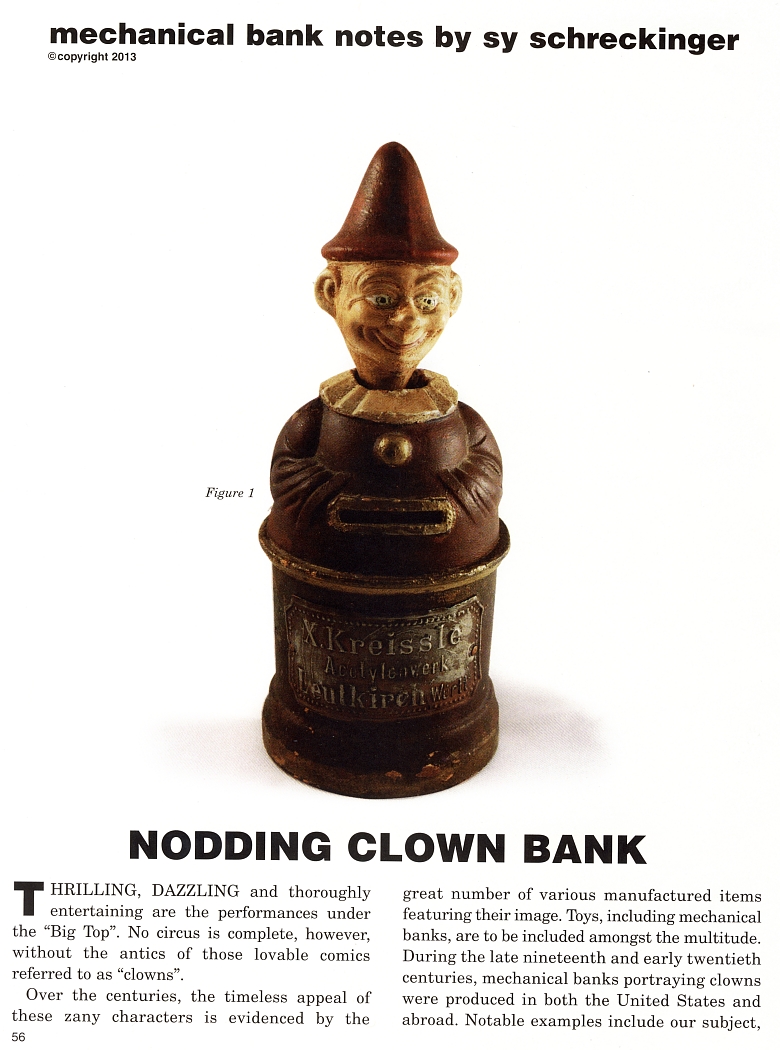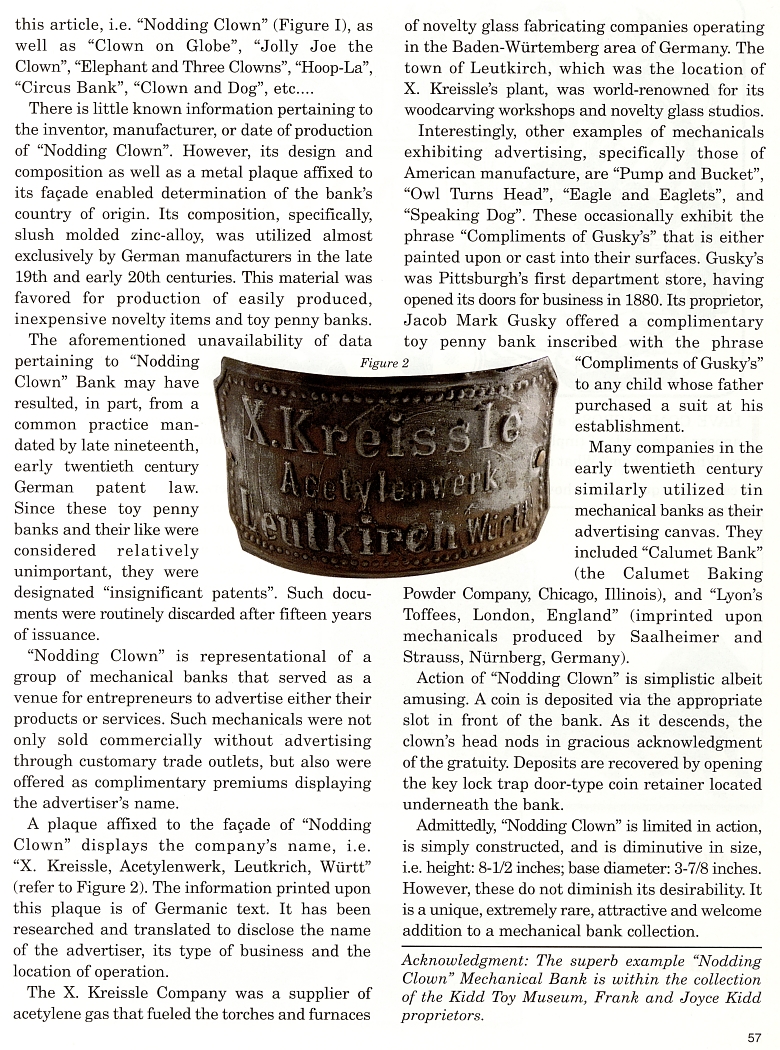|
NODDING CLOWN BANK
by Sy Schreckinger – ANTIQUE TOY WORLD Magazine –
June, 2013
THRILLING, DAZZLING and thoroughly entertaining are the performances
under the "Big Top". No circus is complete, however, without the antics
of those lovable comics referred to as "clowns".
Over the centuries, the timeless appeal of these zany characters is
evidenced by the great number of various manufactured items featuring
their image. Toys, including mechanical banks, are to be included
amongst the multitude. During the late nineteenth and early twentieth
centuries, mechanical banks portraying clowns were produced in both the
United States and abroad. Notable examples include our subject, this
article, i.e. "Nodding Clown" (Figure I), as well as "Clown on Globe",
"Jolly Joe the Clown", "Elephant and Three Clowns", "Hoop-La", "Circus
Bank", "Clown and Dog", etc....
There is little known information pertaining to the inventor,
manufacturer, or date of production of "Nodding Clown". However, its
design and composition as well as a metal plaque affixed to its facade
enabled determination of the bank's country of origin. Its composition,
specifically, slush molded zinc-alloy, was utilized almost exclusively
by German manufacturers in the late 19th and early 20th centuries. This
material was favored for production of easily produced, inexpensive
novelty items and toy penny banks.
The aforementioned unavailability of data pertaining to "Nodding
Figure 2 Clown" Bank may have resulted, in part, from a common practice
mandated by late nineteenth, early twentieth century German patent law.
Since these toy penny banks and their like were considered relatively
unimportant, they were designated "insignificant patents". Such
documents were routinely discarded after fifteen years of issuance.
"Nodding Clown" is representational of a group of mechanical banks
that served as a venue for entrepreneurs to advertise either their
products or services. Such mechanicals were not only sold commercially
without advertising through customary trade outlets, but also were
offered as complimentary premiums displaying the advertiser's name.
A plaque affixed to the facade of "Nodding Clown" displays the
company's name, i.e. "X. Kreissle, Acetylenwerk, Leutkrich, Wart" (refer
to Figure 2). The information printed upon this plaque is of Germanic
text. It has been researched and translated to disclose the name of the
advertiser, its type of business and the location of operation.
The X. Kreissle Company was a supplier of acetylene gas that fueled
the torches and furnaces of novelty glass fabricating companies
operating in the Baden-WUrtemberg area of Germany. The town of Leutkirch,
which was the location of X. Ifreissle's plant, was world-renowned for
its woodcarving workshops and novelty glass studios.
Interestingly, other examples of mechanicals exhibiting
advertising, specifically those of American manufacture, are "Pump and
Bucket", "Owl Turns Head", "Eagle and Eaglets", and "Speaking Dog".
These occasionally exhibit the phrase "Compliments of Gusky's" that is
either painted upon or cast into their surfaces. Gusky's was
Pittsburgh's first department store, having opened its doors for
business in 1880. Its proprietor, Jacob Mark Gusky offered a
complimentary toy penny bank inscribed with the phrase "Compliments of
Gusky's" to any child whose father purchased a suit at his
establishment.
Many companies in the early twentieth century similarly utilized
tin mechanical banks as their advertising canvas. They included "Calumet
Bank" (the Calumet Baking Powder Company, Chicago, Illinois), and
"Lyon's Toffees, London, England" (imprinted upon mechanicals produced
by Saalheimer and Strauss, NUrnberg, Germany).
Action of "Nodding Clown" is simplistic albeit amusing. A coin is
deposited via the appropriate slot in front of the bank. As it descends,
the clown's head nods in gracious acknowledgment of the gratuity.
Deposits are recovered by opening the key lock trap door-type coin
retainer located underneath the bank.
Admittedly, "Nodding Clown" is limited in action, is simply
constructed, and is diminutive in size, i.e. height: 8-1/2 inches; base
diameter: 3-7/8 inches. However, these do not diminish its desirability.
It is a unique, extremely rare, attractive and welcome addition to a
mechanical bank collection.
Acknowledgment: The superb example "Nodding Clown" Mechanical Bank
is within the collection of the Kidd Toy Museum, Frank and Joyce Kidd
proprietors. |

